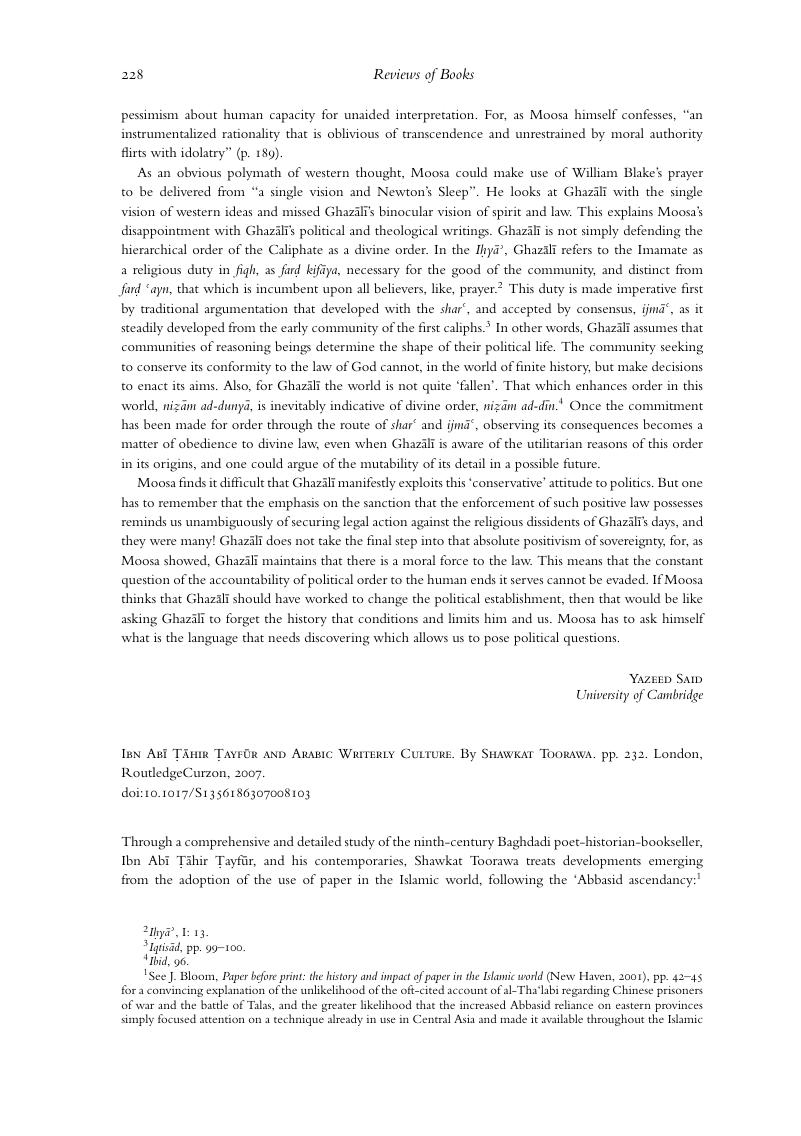No CrossRef data available.
Published online by Cambridge University Press: 14 March 2008

1 See Bloom, J., Paper before print: the history and impact of paper in the Islamic world (New Haven, 2001), pp. 42–45Google Scholar for a convincing explanation of the unlikelihood of the oft-cited account of al-Tha'labi regarding Chinese prisoners of war and the battle of Talas, and the greater likelihood that the increased Abbasid reliance on eastern provinces simply focused attention on a technique already in use in Central Asia and made it available throughout the Islamic empire. See Toorawa, 56, and the notes there for further references regarding the beginnings of the use of paper in the Islamic world.
2 For example, the research of Robert Kraft, David Stern, Talya Fishman, Robert Chartier and Peter Stallybrass, and others, much of it inspired and fostered by the weekly seminar, “History of Material Texts”, founded by Stallybrass in 1993.
3 See, regarding the material culture of the book: J. Bloom, cited above, as well as J. Pedersen, The Arabic Book (tr. G. French; Princeton, 1984). See, regarding the transition in the field of the religious sciences: Cook, M., “The Opponents of the Writing of Tradition in Early Islam”, Arabica 1997 (vol. 44, 4), pp. 437–530CrossRefGoogle Scholar; Schoeler, G., “Writing and Publishing. On the Use and Function of Writing in the First Centuries of Islam,” Arabica 1997 (vol. 44, 3), pp. 423–435CrossRefGoogle Scholar. Toorawa's work includes thorough reference to these sources and more.
4 Chapter Four contains a list of compositions and a brief discussion; Toorawa is currently preparing a detailed discussion of Ibn Abī Ṭāhir's works and their chronology.
5 See in English, Brody, R., The Geonim of Babylonia and the Shaping of Medieval Jewish Culture (New Haven, 1998), esp. pp. 156–160Google Scholar, which includes a brief but enlightening summary of the issues regarding the prestige of orality in ge'onic circles and the revolutionary impact of Sa'adiah Ga'on. In Hebrew, see Drory, R., The Emergence of Jewish-Arabic Literary Contacts at the Beginning of the Tenth Century (Tel Aviv, 1988)Google Scholar, which provides a thorough discussion of the changes in Jewish intellectual life in the East during the ninth and tenth centuries, motivated, in Drory's opinion, largely by Karaite scholarship. Parts of this book were published in English translation: see Drory, R., Models and Contacts: Medieval Arabic Literature and Its Impact on Jewish Literature (Leiden, 2000).Google Scholar See also, most recently, in Hebrew, Danzig, N., “From Oral Talmud to Written Talmud: On the Methods of Transmission of the Babylonian Talmud and its Study in the Middle Ages”, Annual of Bar-Ilan University (Ramat Gan, 2006), pp. 49–112Google Scholar.